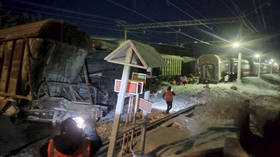Mystery greenhouse gas warmed Mars making water flow 3.8bln years ago - study

Water might have flowed on Mars 3.8 billion years ago as unusual greenhouse gasses warmed the Red Planet - at least that is what new research suggests.
By creating a one-dimensional climate model scientists from Penn State University showed that an atmosphere with sufficient carbon dioxide, water and hydrogen could have caused surface temperatures on Mars to rise above freezing, making the atmosphere warm enough for water.
This would have allowed water to create the ancient Grand Canyon-like valley networks, such as the Nanendi Valles, according to new research published in Nature Geoscience magazine.

“This is exciting, because explaining how early Mars could
have been warm and wet enough to form the ancient valleys had
scientists scratching their heads for the past 30 years. We think
we may have a credible solution to this great
mystery,” Ramses Ramirez, one of the researchers, told
Physics.org.
Ramirez and his fellow researchers demonstrated the possibility that volcanic activity could have created enough hydrogen and carbon dioxide to form a greenhouse effect, which would have raised temperatures sufficiently to allow liquid water.
They then ran the model using new hydrogen absorption data, which allowed them to recreate the conditions on Mars when the sun was 30 percent less bright than it is today.
“It’s kind of surprising to think that Mars could have been warm and wet, because at the time the sun was much dimmer,” Ramirez said.
The scientists discounted previous alternative theories as to what formed Martian valleys. One theory, whereby large meteorites bombarded the planet, which then generated steam atmosphere which rained, was dropped because it would not have been able to produce enough water to carve out the valleys.
“We think that there is no way to form the ancient valleys with any of the alternate cold early Mars models. So we hope our results will get people to reconsider their positions,” Ramirez added.
He added that carbon dioxide and other background gases could “perturb” the hydrogen molecule and make it function “as a powerful greenhouse gas at wavelengths where carbon dioxide and water don’t absorb too strongly.”















